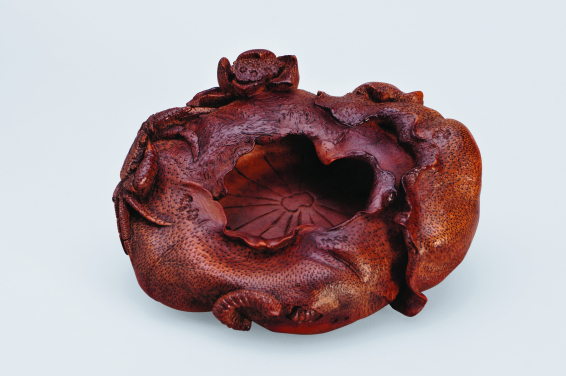Media
The Spirit of the Literati in Bamboo
Art of the Iron Brush: Bamboo Carvings from the Ming and Qing Dynasties
16 Apr 2019

Brush washer
China, Qing dynasty
Late 17th or 18th century
Bamboo root
5 x 15 cm
© Sanyu Tang Collection
(From left) Ribbon-cutting ceremony by Ms Phyllis Chan, the Sanyu Tang Collection Mr Paul Yu Pui Keung, UMAG Director Dr Florian Knothe and UMAG Assistant Curator Mr Ben Chiesa.
Pine-shaped cup
Jiading, China, Ming or Qing dynasty
17th century
Signed: Wuzheng Daoren
Bamboo root
Height 10.5 cm
© Sanyu Tang Collection
Lioness and cub
China, Qing dynasty
Late 18th or early 19th century
Signed: Hongyu Zuo
Bamboo root
Height 15 cm
© Sanyu Tang Collection
Pair of immortals
China, Qing dynasty
Late 18th century
Bamboo root and lacquer
Height 12.8 and 13 cm
© Sanyu Tang Collection
- 1 / 5
- 2 / 5
- 3 / 5
- 4 / 5
- 5 / 5
The University Museum and Art Gallery (UMAG) of the University of Hong Kong (HKU) will present Art of the Iron Brush: Bamboo Carvings from the Ming and Qing Dynasties from April 17 to July 28, 2019.
Durable, flexible and abundant in nature, bamboo has been used as a material and a subject in Chinese art for millennia. At first woven into baskets, containers and other everyday objects during the Neolithic period, over successive centuries bamboo came to be used in increasingly sophisticated ways, at the same time attaining numerous symbolic meanings. Because it bends in a storm but does not break, it was particularly associated with the integrity and personal virtue of the scholarly elite, who embraced its symbolic value by producing, acquiring and displaying delicate bamboo objects suitable for various scholarly pursuits, such as painting and calligraphy.
During the Ming dynasty (1368–1644), scholarly and imperial patronage transformed bamboo carving into a major art form. Scholar-carvers and workshops centred around Jiading (in present-day Shanghai) and Jinling (now Nanjing) produced large numbers of brush pots, wrist rests, miniature landscapes, figurines and other objects. Many bamboo carvers also worked in other materials soft enough to be manipulated with the ‘iron brush’ — a term for knives and other carving tools used by literati to transfer their brushwork aesthetic to other media — including boxwood, rhinoceros’ horns and ivory, which shared a kind of loose identity under the heading of diaoke (‘carving’ in modern Chinese). Small in scale yet teeming with life, these works reflect prodigious technical skill and great imaginary involvement because of the unique shapes and contortions of the materials involved.
An opening ceremony of the exhibition was held at UMAG today (April 16). Officiating guests included the Sanyu Tang Collection Mr Paul Yu Pui Keung and UMAG Director Dr Florian Knothe.
For more images and captions of the exhibits, please click here.
Details of the Exhibition
Period: April 17, 2019 (Wednesday) to July 28, 2019 (Sunday)
Opening Hours:
09:30 – 18:00 (Monday to Saturday)
13:00 – 18:00 (Sunday)
Closed on University and Public Holidays
Venue: 2/F, Fung Ping Shan Building, UMAG, HKU, 90 Bonham Road, Pokfulam
Tel/Email: (852) 2241 5500 (General Enquiry) / museum@hku.hk
Admission: Free
Website: http://www.umag.hku.hk/en/
Connect with UMAG on social media:
Facebook: http://bit.ly/umag_facebook
Instagram: @umag_hku, #UMAG, #Bamboo, #BambooCarving, #MingDynasty, #QingDynasty
Weibo: @香港大學美術博物館UMAG
YouTube: http://bit.ly/umag_youtube
LinkedIn: http://bit.ly/umag_linkedin
About University Museum and Art Gallery of the University of Hong Kong (UMAG)
UMAG was founded in 1953 as the Fung Ping Shan Museum. It was originally established as the Fung Ping Shan Library in 1932 in honour of its benefactor. For more information on UMAG, please click here.
Media enquiries
UMAG Senior Communications Officer Ms Elena Cheung, Tel: (852) 2241 5512, Email: elenac@hku.hk
UMAG Programme Officer Ms Chelsea Choi, Tel: (852) 2241 5509, Email: cchelsea@hku.hk
